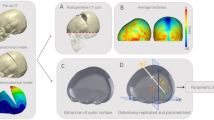Abstract
Introduction
A posterior flatness of the skull vault can be observed in infants with brachycephaly. Such posterior deformation favours the development of turricephaly which is difficult to correct. To reduce the risk of such deformation, an early posterior skull remodelling has been suggested. Translambdoid springs can be used to allow for a distraction through the patent lambdoid sutures and obtain a progressive increase of the posterior skull volume.
Surgical technique
The procedure consists in a posterior scalp elevation, the patient being on a prone position. Springs made of stainless steel wire (1.5 mm in diameter) are bent in a U-type fashion, and strategically positioned across both lambdoid sutures. No drilling is usually necessary, as the lambdoid suture can be gently forced with a subperiosteal elevator in its middle and an indentation can be created with a bony rongeur on each side of the open suture to allow for a self-retention of bayonet-shaped extremity of the spring. Careful attention is addressed to the favoured prone position during the post-operative period. After a delay of 3–6 months, the springs can be removed during a second uneventful procedure, with limited incisions, usually as a preliminary step of the subsequent frontal remodelling.
Conclusion
The concept of spring-assisted expansion across patent sutures under 6 months of age was confirmed in our experience (19 cases). Insertion of the springs allowed for immediate distraction across the suture. A posterior remodelling of the skull could be achieved with minimal morbidity allowing to delay safely a radical anterior surgery.






Similar content being viewed by others
References
Arnaud E, Marchac A, Marchac D, Renier D (2007) Spring assisted skull expansion for posterior cephalic flatness in infants. Proceedings of the XIIth ISCFS Congress, Salvador, Brazil, 23–25
Arnaud E, Marchac D, Renier D (2007) Reduction of morbidity of the frontofacial monobloc advancement in children by the use of internal distraction. Plast Reconstr Surg 120(4):1009–1026
Di Rocco F, Arnaud E, Renier D (2009) Evolution in the frequency of nonsyndromic craniosynostosis. J Neurosurg Pediatr 4(1):21–25
Di Rocco F, Arnaud E, Meyer P, Sainte-Rose C, Renier D (2009) Focus session on the changing “epidemiology” of craniosynostosis (comparing two quinquennia: 1985–1989 and 2003–2007) and its impact on the daily clinical practice: a review from Necker Enfants Malades. Childs Nerv Syst 25(7):807–811
Gewalli F, da Silva Guimaraes-Ferreira JP, Maltese G, Ortengren U, Lauritzen C (2001) Expander elements in craniofacial surgery: an experimental study in rabbits. Scand J Plast Reconstr Surg Hand Surg 35(2):149
Maltese G, Tamow P, Lauritzen C (2007) Spring-assisted correction of hypotelorism in metopic synostosis. Plast Reconstr Surg 119(3):977–984
Marchac D, Renier D (1982) Craniofacial surgery for craniosynostosis. Little Brown Eds, Boston
Renier D, Sainte-Rose C, Marchac D, Hirsch JF (1982) Intracranial pressure in craniostenosis. J Neurosurg 57(3):370–377
Sgouros S, Goldin JH, Hockley AD, Wake MJC (1996) Posterior skull surgery in craniosynostosis. Child's Nerv Syst 12:727–733
Acknowledgments
The authors acknowledge Claes Lauritzen for transmitting his experience about spring devices during a scientific visit to Goteborg craniofacial centre in 2006.
Author information
Authors and Affiliations
Corresponding author
Rights and permissions
About this article
Cite this article
Arnaud, E., Marchac, A., Jeblaoui, Y. et al. Spring-assisted posterior skull expansion without osteotomies. Childs Nerv Syst 28, 1545–1549 (2012). https://doi.org/10.1007/s00381-012-1843-4
Received:
Accepted:
Published:
Issue Date:
DOI: https://doi.org/10.1007/s00381-012-1843-4




